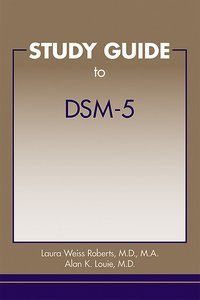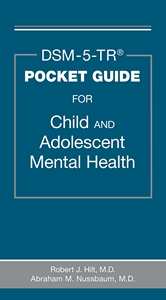Study Guide to DSM-5®
View Pricing
Description
The Study Guide to DSM-5 is an indispensable instructional supplement to DSM-5 to help teachers and students of psychiatry, psychology, social work, medical schools, and residency programs understand and apply diagnostic criteria and key clinical concepts through a variety of learning tools. The Study Guide can stand alone as a training supplement to DSM-5 or be paired with DSM-5 Clinical Cases as comprehensive instruction for understanding and applying DSM-5.
The Study Guide possesses a multitude of features that will benefit both learner and instructor:
- Foundational concepts of diagnosis are amplified with case vignettes, discussion questions, and recommended reading to enrich knowledge and practice.
- Content and features are consistent across the chapters for diagnostic classes. These chapters include an introduction, diagnostic pearls, summary discussion, and self-assessment questions and answers. In-depth discussions of key diagnoses within each class cover approach to the diagnosis, getting the history, diagnostic tips, clinical vignettes, and differential diagnosis.
- Key clinical vignettes exemplify diagnostic criteria while reflecting the complexity of real-life scenarios. In addition, examples are offered to help readers appreciate diagnostic variations and ambiguities.
- Discussion points and questions for self-assessment are provided for each diagnostic class throughout the guide, allowing readers to test their understanding of DSM-5 and helping teachers to focus on the most critical issues.
- A special section dedicated to an overview of diagnostic questions that cover material across the Study Guide and DSM-5 provides additional testing of knowledge, along with an answer key.
Engagingly written, the Study Guide to DSM-5 introduces learners to DSM-5 and provides them with the tools they need to fully understand and deftly apply DSM-5 concepts and criteria.
Contents
- Introduction
- Part I: Foundations
- Chapter 1. Diagnosis and DSM-5
- Chapter 2. Arriving at a diagnosis: the role of the clinical interview
- Chapter 3. Understanding different approaches to diagnostic classification
- Part II: DSM-5 Diagnostic Classes
- Chapter 4. Neurodevelopmental disorders
- Chapter 5. Schizophrenia spectrum and other psychotic disorders
- Chapter 6. Bipolar and related disorders
- Chapter 7. Depressive disorders
- Chapter 8. Anxiety disorders
- Chapter 9. Obsessive-compulsive and related disorders
- Chapter 10. Trauma- and stressor-related disorders
- Chapter 11. Dissociative disorders
- Chapter 12. Somatic symptom and related disorders
- Chapter 13. Feeding and eating disorders
- Chapter 14. Elimination disorders
- Chapter 15. Sleep-wake disorders
- Chapter 16. Sexual dysfunctions
- Chapter 17. Gender dysphoria
- Chapter 18. Disruptive, impulse-control, and conduct disorders
- Chapter 19. Substance-related and addictive disorders
- Chapter 20. Neurocognitive disorders
- Chapter 21. Personality disorders
- Chapter 22. Paraphilic disorders
- Part III: Test Yourself
- Chapter 23. Questions and answers
- Index
Contributors
- Elias Aboujaoude, M.D., M.A.
Bruce A. Arnow, Ph.D.
Sepideh N. Bajestan, M.D., Ph.D.
Richard Balon, M.D.
Cara Bohon, Ph.D.
Kimberly L. Brodsky, Ph.D.
John H. Coverdale, M.D., M.Ed.
Whitney Daniels, M.D.
Jennifer Derenne, M.D.
Kathleen Kara Fitzpatrick, Ph.D.
M. Rameen Ghorieshi, M.D., M.P.H.
Cheryl Gore-Felton, Ph.D.
Carlos C. Greaves, M.D.
Thomas W. Heinrich, M.D.
Robert M. Holaway, Ph.D.
David S. Hong, M.D.
Honor Hsin, M.D., Ph.D.
Terence A. Ketter, M.D.
Cheryl Koopman, Ph.D.
John Lauriello, M.D.
Alan K. Louie, M.D.
Daniel Mason, M.D.
Shefali Miller, M.D.
Ruth O'Hara, Ph.D.
Maurice M. Ohayon, M.D., D.Sc., Ph.D.
Michael J. Ostacher, M.D., M.P.H., M.M.Sc.
Yasmin Owusu, M.D.
Michelle Primeau, M.D.
Tahir Rahman, M.D.
Daryn Reicherter, M.D.
Margaret Reynolds-May, M.D.
Laura Weiss Roberts, M.D., M.A.
Allyson C. Rosen, Ph.D.
Ann C. Schwartz, M.D.
Yelizaveta I. Sher, M.D.
Daphne Simeon, M.D.
David Spiegel, M.D.
Hans Steiner, M.D.
Mickey Trockel, M.D., Ph.D.
Tonita E. Wroolie, Ph.D.
Jerome Yesavage, M.D.
Brian Yochim, Ph.D.
Maya Yutsis, Ph.D.
Sanno E. Zack, Ph.D.
About the Authors
Laura Weiss Roberts, M.D., M.A., is Chairman and Katharine Dexter McCormick and Stanley McCormick Memorial Professor in the Department of Psychiatry and Behavioral Sciences at Stanford University School of Medicine and Chief of Psychiatry Service at Stanford Hospital and Clinics, Stanford, California. She is also Editor-in-Chief of Academic Psychiatry.
Alan K. Louie, M.D., is Professor, Associate Chair, and Director of Education in the Department of Psychiatry and Behavioral Sciences at Stanford University School of Medicine, Stanford, California.
Related Products
Carousel Control - items will scroll by tabbing through them, otherwise arrows can be used to scroll one item at a time








